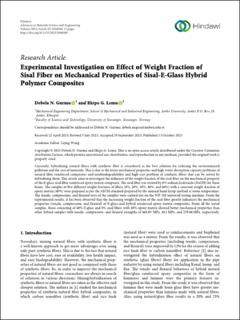| dc.contributor.author | Gurmu, Debela N. | |
| dc.contributor.author | Lemu, Hirpa G. | |
| dc.date.accessioned | 2023-11-15T09:17:45Z | |
| dc.date.available | 2023-11-15T09:17:45Z | |
| dc.date.created | 2023-11-11T10:33:12Z | |
| dc.date.issued | 2023 | |
| dc.identifier.citation | Gurmu, D. N., & Lemu, H. G. (2023). Experimental Investigation on Effect of Weight Fraction of Sisal Fiber on Mechanical Properties of Sisal-E-Glass Hybrid Polymer Composites. Advances in Materials Science and Engineering, 2023. | en_US |
| dc.identifier.issn | 1687-8434 | |
| dc.identifier.uri | https://hdl.handle.net/11250/3102633 | |
| dc.description.abstract | Currently, hybridizing natural fibers with synthetic fiber is considered as the best solution for reducing the environmental pollution and the cost of materials. This is due to the lower mechanical properties and high water absorption capacity problems of natural fiber reinforced composites and nonbiodegradability and high-cost problem of synthetic fibers that can be solved by hybridizing them. This article aims to investigate the influence of the weight fraction of the sisal fiber on the mechanical property of the E-glass-sisal fiber reinforced epoxy matrix composite. The sisal fiber was treated by 8% sodium hydroxide (NaOH) for three hours. The samples of five different weight fractions of fibers (0%, 20%, 30%, 40%, and 60%) with a constant weight fraction of epoxy matrix (40%) were prepared as per the ASTM standard prepared by the manual hand layup method at room temperature. The tensile, compression, and flexural tests of the samples were carried out on the WP 310 universal testing machine. From the experimental results, it has been observed that the increasing weight fraction of the sisal fiber greatly influences the mechanical properties (tensile, compression, and flexural) of E-glass-sisal hybrid reinforced epoxy matrix composites. From all the tested samples, those consisting of 60% E-glass and 0% sisal fibers with 40% epoxy matrix showed better mechanical properties than other hybrid samples with tensile, compressive, and flexural strengths of 464.03 MPa, 40.1 MPa, and 239.06 MPa, respectively. | en_US |
| dc.language.iso | eng | en_US |
| dc.publisher | Hindawi | en_US |
| dc.rights | Navngivelse 4.0 Internasjonal | * |
| dc.rights.uri | http://creativecommons.org/licenses/by/4.0/deed.no | * |
| dc.title | Experimental Investigation on Effect of Weight Fraction of Sisal Fiber on Mechanical Properties of Sisal-E-Glass Hybrid Polymer Composites | en_US |
| dc.title.alternative | Experimental Investigation on Effect of Weight Fraction of Sisal Fiber on Mechanical Properties of Sisal-E-Glass Hybrid Polymer Composites | en_US |
| dc.type | Peer reviewed | en_US |
| dc.type | Journal article | en_US |
| dc.description.version | publishedVersion | en_US |
| dc.rights.holder | © The Author(s) 2023 | en_US |
| dc.subject.nsi | VDP::Matematikk og Naturvitenskap: 400 | en_US |
| dc.source.volume | 2023 | en_US |
| dc.source.journal | Advances in Materials Science and Engineering | en_US |
| dc.identifier.doi | 10.1155/2023/3948500 | |
| dc.identifier.cristin | 2195324 | |
| cristin.ispublished | true | |
| cristin.fulltext | original | |
| cristin.qualitycode | 1 | |

